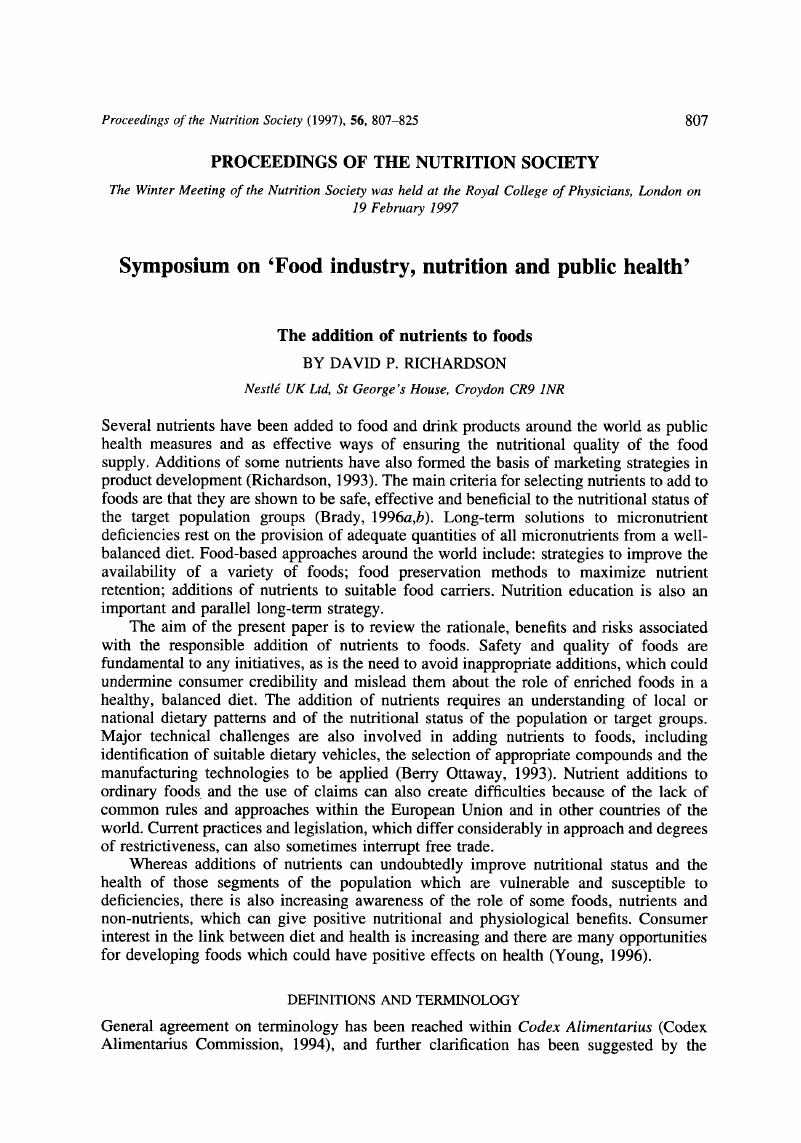Crossref Citations
This article has been cited by the following publications. This list is generated based on data provided by Crossref.
Reilly, Conor
1998.
Selenium: A new entrant into the functional food arena.
Trends in Food Science & Technology,
Vol. 9,
Issue. 3,
p.
114.
Godfrey, David
and
Richardson, David
2002.
Vitamins and minerals for health.
British Food Journal,
Vol. 104,
Issue. 11,
p.
913.
Fletcher, Reginald J.
Bell, Ian P.
and
Lambert, Janet P.
2004.
Public health aspects of food fortification: a question of balance.
Proceedings of the Nutrition Society,
Vol. 63,
Issue. 4,
p.
605.
Ziadeh, Ghada
Shadarevian, Sossy
Malek, Amal
Khalil, Joanna
Haddad, Tharwat
Haddad, John
and
Toufeili, Imad
2005.
Determination of Sensory Thresholds of Selected Calcium Salts and Formulation of Calcium‐fortified Pocket‐type Flat Bread.
Journal of Food Science,
Vol. 70,
Issue. 8,
Liberato, Selma Coelho
and
Pinheiro-Sant'Ana, Helena Maria
2006.
Fortification of industrialized foods with vitamins.
Revista de Nutrição,
Vol. 19,
Issue. 2,
p.
215.
Richardson, David P.
2007.
Risk management of vitamins and minerals: a risk categorisation model for the setting of maximum levels in food supplements and fortified foods.
Food Science & Technology Bulletin: Functional Foods,
Vol. 4,
Issue. 6,
p.
51.
Hannon, Evelyn M.
Kiely, Mairead
and
Flynn, Albert
2007.
The impact of voluntary fortification of foods on micronutrient intakes in Irish adults.
British Journal of Nutrition,
Vol. 97,
Issue. 6,
p.
1177.
Venkatesh Mannar, M.G.
and
Wesley, A.S.
2008.
International Encyclopedia of Public Health.
p.
622.
Joyce, Triona
Hannon, Evelyn M.
Kiely, Mairead
and
Flynn, Albert
2008.
Analysis of the impact of fortified food consumption on overall dietary quality in Irish adults.
British Journal of Nutrition,
Vol. 101,
Issue. 3,
p.
431.
Richardson, David P.
2010.
Risk management of vitamins and minerals in Europe: quantitative and qualitative approaches for setting maximum levels in food supplements for children.
Food Science & Technology Bulletin: Functional Foods,
Vol. 7,
Issue. 6,
p.
77.
Black, Lucinda J
Walton, Janette
Flynn, Albert
Cashman, Kevin D
and
Kiely, Mairead
2015.
Small Increments in Vitamin D Intake by Irish Adults over a Decade Show That Strategic Initiatives to Fortify the Food Supply Are Needed.
The Journal of Nutrition,
Vol. 145,
Issue. 5,
p.
969.
Richardson, David P.
2015.
Science and the Law: How the Communication of Science Affects Policy Development in the Environment, Food, Health, and Transport Sectors.
Vol. 1207,
Issue. ,
p.
153.
Mannar, M.G. Venkatesh
and
Wesley, Annie S.
2017.
International Encyclopedia of Public Health.
p.
143.
Okafor, Uchechukwu I.
Omemu, Adebunkola M.
Obadina, Adewale O.
Bankole, Mobolaji O.
and
Adeyeye, Samuel A. O.
2018.
Nutritional composition and antinutritional properties of maize ogi cofermented with pigeon pea.
Food Science & Nutrition,
Vol. 6,
Issue. 2,
p.
424.
Babarinde, G. O.
Adeyanju, J. A.
Ogunleye, K. Y.
Adegbola, G. M.
Ebun, A. A.
and
Wadele, D.
2020.
Nutritional composition of gluten-free flour from blend of fonio (Digitaria iburua) and pigeon pea (Cajanus cajan) and its suitability for breakfast food.
Journal of Food Science and Technology,
Vol. 57,
Issue. 10,
p.
3611.
Abinash, V.
Rahul, T.
Antoniraj, M.G.
Moses, J.A.
and
Anandharamakrishnan, C.
2021.
Food, Medical, and Environmental Applications of Polysaccharides.
p.
161.
Chen, Lianmin
and
Guo, Mingyu
2021.
Highly Transparent, Stretchable, and Conductive Supramolecular Ionogels Integrated with Three-Dimensional Printable, Adhesive, Healable, and Recyclable Character.
ACS Applied Materials & Interfaces,
Vol. 13,
Issue. 21,
p.
25365.





